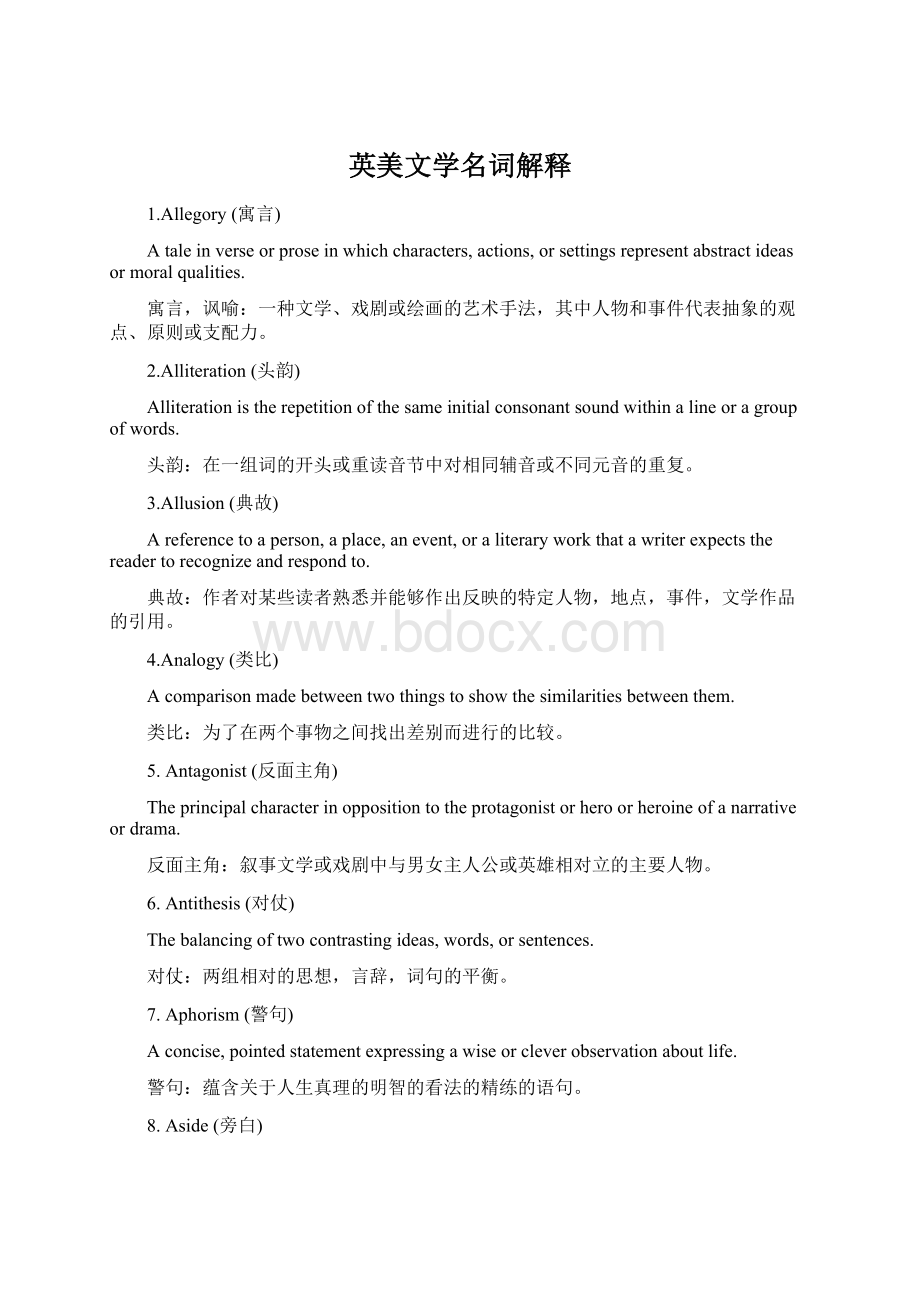英美文学名词解释.docx
《英美文学名词解释.docx》由会员分享,可在线阅读,更多相关《英美文学名词解释.docx(14页珍藏版)》请在冰豆网上搜索。

英美文学名词解释
1.Allegory(寓言)
Ataleinverseorproseinwhichcharacters,actions,orsettingsrepresentabstractideasormoralqualities.
寓言,讽喻:
一种文学、戏剧或绘画的艺术手法,其中人物和事件代表抽象的观点、原则或支配力。
2.Alliteration(头韵)
Alliterationistherepetitionofthesameinitialconsonantsoundwithinalineoragroupofwords.
头韵:
在一组词的开头或重读音节中对相同辅音或不同元音的重复。
3.Allusion(典故)
Areferencetoaperson,aplace,anevent,oraliteraryworkthatawriterexpectsthereadertorecognizeandrespondto.
典故:
作者对某些读者熟悉并能够作出反映的特定人物,地点,事件,文学作品的引用。
4.Analogy(类比)
Acomparisonmadebetweentwothingstoshowthesimilaritiesbetweenthem.
类比:
为了在两个事物之间找出差别而进行的比较。
5.Antagonist(反面主角)
Theprincipalcharacterinoppositiontotheprotagonistorheroorheroineofanarrativeordrama.
反面主角:
叙事文学或戏剧中与男女主人公或英雄相对立的主要人物。
6.Antithesis(对仗)
Thebalancingoftwocontrastingideas,words,orsentences.
对仗:
两组相对的思想,言辞,词句的平衡。
7.Aphorism(警句)
Aconcise,pointedstatementexpressingawiseorcleverobservationaboutlife.
警句:
蕴含关于人生真理的明智的看法的精练的语句。
8.Aside(旁白)
Apieceofdialogueintendedfortheaudienceandsupposedlynotheardbyotheractorsonstage.
旁白:
只说给观众而认为不会让台上其他演员听到的一段对话。
9.Apostrophe(呼语)
Thedirectaddressofanabsentorimaginarypersonorofapersonifiedabstraction,especiallyasadigressioninthecourseofaspeechorcomposition.
呼语:
直接称呼不在场或虚构的人物或称呼拟人的事物,尤指作为演讲或作文过程中的离题话。
10.Assonance(类韵)
Therepetitionofsimilarvowelsounds,especiallyinpoetry.
类音,类韵:
相同或相似元音的重复,尤其指在诗歌中的重复。
11.Atmosphere(氛围)
Theprevailingmoodorfeelingofaliterarywork.
12.Autobiography(自传)
Aperson‘saccountofhisorherownlife.
13.Ballad(民谣)
Anarrativepoem,oftenoffolkoriginandintendedtobesung.
14.BalladStanza(民谣诗节)
Atypeoffour-linestanza,thefirstandthethirdlineshavefourstressedwordsorsyllables;thesecondandfourthlineshavethreestresses.
15.Biography(传记)
Adetailedaccountofaperson‘slifewrittenbyanotherperson.
传记:
由他人篆写的关于某人生平的详细记录。
16.BlankVerse(无韵体诗)
Versewritteninunrhymediambicpentameter.
17.Caesura(休止)
Abreakorpauseinalineofpoetry.
18.Canto(章)
Oneoftheprincipaldivisionsofalongpoem..
诗章:
一首长诗的主要部分之一。
19.Caricature(夸张讽刺)
Theuseofexaggerationordistortiontomakeafigureappearcomicorridiculous.
夸张讽刺:
为了使文中的人物显得可笑而使用的夸张或扭曲人物形象的手法。
20.Characterization(人物刻画)
Themeansbywhichawriterrevealsthepersonalityofacharacter.
人物刻画:
作者表现作品中人物性格的方法。
21.Classicism(古典主义)
Amovementortendencyinart,literature,ormusicthatreflectstheprinciplesmanifestedintheartofancientGreeceandRome.
古典主义:
一种在文学,艺术,音乐领域体现古代希腊,罗马风格的运动。
22.Climax(高潮)
Thepointofgreatestintensity,interest,orsuspenseinanarrative.
23.Comedy(喜剧)
Adramaticworkthatisoftenhumorousorsatiricalintoneandusuallycontainsahappyresolutionofthethematicconflict.
喜剧:
轻松的和常有幽默感的或在调子上是讽刺的戏剧作品,常包括主题冲突的愉快解决
24.Conceit(奇想)
Akindofmetaphorthatmakesacomparisonbetweentwostartlinglydifferentthings.
奇想:
一种在截然不同的事物之间建立起的比喻。
25.Conflict(冲突)
Astrugglebetweentwoopposingforcesorcharactersinashortstory,novel,play,ornarrativepoem.
冲突:
故事,小说,戏剧中相对的力量和人物之间的对立。
26.Connotation(外延)
Alltheemotionsandassociationsthatawordorphrasemayarouse.
外延:
包括单词字面意思之外的或被该词汇唤起的全部内涵的意义。
27.Consonance(辅音韵)
Therepetitionofconsonantsoraconsonantpattern,especiallyattheendsofwords.
辅音韵:
辅音或辅音模式的重复,尤指位于词尾的。
28.Couplet(双韵体)
Aunitofverseconsistingoftwosuccessivelines,usuallyrhymingandhavingthesamemeterandoftenformingacompletethoughtorsyntacticunit.
双韵体:
包括两个相连的诗行的一种诗的单位,通常压韵并具有同样的格律,经常组成一个完整的意思和句法单位
29.Heroiccouplet(英雄双韵体)
Acoupletwritteniniambicpentameteriscalledaheroiccouplet.
英雄双韵体:
五步抑扬格的双韵体称英雄双韵体。
30.Denotation(内涵)
Theliteralordictionarymeaningofaword.
直接意义:
一个词的字面意义或词典意义。
31.Denouement(结局)
Thefinalresolutionorclarificationofadramaticornarrativeplot.
结局:
戏剧或叙事场景的最后结果。
32.Diction(措辞)
Awriter‘schoiceanduseofwordsinspeechorwriting,particularlyforclarity,effectiveness,andprecision.
措词:
讲话或书写中,出于表述清晰,言简意赅对词语的使用或选择。
33.Dissonance(不协和)
Aharshordisagreeablecombinationofsounds;discord.
34.Dramaticmonologue(戏剧独白)
Akindofnarrativepoeminwhichonecharacterspeakstooneormorelistenerswhoserepliesarenotgiveninthepoem.
35.Elegy(挽歌)
Apoemorsongcomposedespeciallyasalamentforadeceasedperson.
挽歌,挽诗:
专门为悼念某一死者所写的诗或歌.
36.EmblematicImage(象征)
Averbalpictureoffigurewithalongtraditionofmoralorreligiousmeaningattachedtoit.
37.Epic(史诗)
Anextendednarrativepoeminelevatedordignifiedlanguage,celebratingthefeatsofalegendaryortraditionalhero.
史诗:
用严肃或庄重的语言写成的叙事长诗,歌颂传奇中或历史上英雄的丰功伟绩
38.Epigram(隽语)
Aconcise,clever,oftenparadoxicalstatement,susallyintheformofapoem.
隽语:
一个简明,机智,常常似是而非的陈述,经常以诗的形式出现
39.Epigraph(引语/开场白)
Amottoorquotationatthebeginningofaliterarycomposition,settingforthatheme.
引语:
在一部文学作品开头的引言,警句,阐明主题
40.Epilogue(结语/收场白)
Ashortadditionorconcludingsectionattheendofaliterarywork,oftendealingwiththefutureofitscharacters.AlsocalledInthissense,alsocalledafterword
结语:
文学作品结束时简短的附加或总结性章节,常常关于作品人物的未来也作在此意义上也可称作afterword.
41.Epiphany(顿悟)
Amomentofillumination,usuallyoccurrsatorneartheendofawork.
顿悟:
对现实真谛的顿悟或洞察,通常出现在作品的结尾.
42.Epitaph(墓志铭)
Aninscriptiononatombstoneorinashortpoeminmemoryofsomeonewhohasbeendead.
墓志铭:
刻于墓碑上用以怀念死者的碑铭.
43.Epithet(表述词语)
Atermusedtocharacterizeapersonorthing。
表述词语:
用来表示某人某物特性的一个表达。
44.Essay(散文)
Ashortliterarycompositiononasinglesubject,usuallypresentingthepersonalviewoftheauthor.
散文:
内容通常论及一个主题的短小文章,通常表达作者个人的观点
45.Exemplum(说教故事)
Atale,usuallyinsertedintothetextofasermon,thatillustratesamoralprinciple.
说教故事:
一种短小的体现某种道德原则的故事性文章,通常出现在布道文中。
46.Fable(寓言)
Abriefstorythatistoldtopresentamoral,orpracticallesson.
寓言:
一种体现某种道德观念或实用价值的说教性文章。
47.Farce(轻喜剧)
Akindofcomedybasedonaridiculoussituation,oftenwithstereotypedcharacters.
轻喜剧:
一种以可笑的情节的为基础的喜剧,通常包含固定的角色。
48.FigurativeLanguage(象征性语言)
Languagethatisnotintendedtobeinterpretedinaliteralsense.
象征性语言:
不能直接用字面意义来理解的语言。
49.FigureofSpeech(比喻)
Awordoranexpressionthatisnotmeanttobeinterpretedinliteralsense.
比喻:
不能直接按照字面意义理解的词语或表述方法。
50.Flashback(倒叙)
Aliterarydeviceinwhichanearliereventisinsertedintoanarrative.
倒叙,闪回镜头:
一种文学或电影的表现手法,往往在一段按正常时间顺序记叙的叙事中插入一件以前发生过的事情
51.Foil(陪衬)
Acharacterwhosetsoffanothercharacterbycontrast.
陪衬:
用来反衬其他人物的人物。
52.Foreshadowing(铺垫)
Theuseofhintsorcluesinanarrativetosuggestwhatwillhappenlater.
铺垫:
用来预示将要发生的事情的线索或暗示。
53.Freeverse(自由诗体)
Versesthathasneitherametricalpatternoranregularpattern.
自由诗体:
既不具格式韵律又不具常规格律的诗体。
54.hyperbole(夸张法)
Afigureofspeechinwhichexaggerationisusedforemphasisoreffect
夸张法:
一种比喻,使用夸张来强调或产生某种效果。
55.Iambicpentameter(五步抑扬格)
Apoeticlineconsistingoffiveversefeet,witheachfootaniamb--thatis,anunstressedsyllablefollowedbyastressedsyllable.
五步抑扬格:
一种诗句形式,每行诗句包含五个抑扬格音步。
56.Imagery(意象)
Wordsorphrasesthatcreatepictures,orimages,inreaders‘mind.
意象:
用来在读者的思维中唤起某种图示或形象的词汇。
57.Incrementalrepetition(递进重复)
Therepetitionofapreviouslineorlines,butwithaslightvariationeachtimethatadvancesthenarrativestanzabystanza.
递进重复:
诗歌中对上文中一行或几行的重复,但每次重复都有一定的变化,而且每一节的重复中的叙述都有所强化。
58.Inversion(倒装句)
Thetechniqueofreversing,orinvertingthenormalwordorderofasentence.
倒装句:
一种将句子正常的表达方法倒置的技巧。
59.Invocation(开篇祷告)
Acalltoamuse,godorspiritforinspirationatthebeginningofanepicorotherpoem.
开篇祷告:
在史诗或诗歌的开篇企求神灵给予启示的文字。
60.Irony(反语)
Acontrastbetweenwhatisstatedandwhatisreallymeant,orbetweenwhatisexpectedtohappenandwhatactuallyhappened.
反语:
一种建立在字面表述和真实意义上或期待产生的结果和真实的结果之间的对比。
61.Kenning(隐喻语)
Afigurative,usuallycompoundexpressionusedinplaceofanameornoun,especiallyinOldEnglishandOldNorsepoetry.forexample,stormofswordsisakenningforbattle.
隐喻语:
尤指古英语和古斯堪的纳维亚语诗中,一种比喻性的,在表名字或名词时常用的复合表达方式,如“剑的风暴”是“战争”的隐喻语
62.Lyric(抒情诗)
Apoem,usuallyashortone,thatexpressesaspeaker‘spersonalthoughtsorfeelings.
抒情诗:
一种用来抒发作者感情或思想的短诗。
63.Masque(假面剧)
Adramaticentertainment,usuallyperformedbymaskedplayersrepresentingmythologicalorallegoricalfigures,thatwaspopularinEnglandinthe16thandearly17thcenturies.
假面剧:
一种戏剧性娱乐,由代表神话或寓言中人物的佩戴面具者表演,该娱乐形式在16世纪和17世纪早期的英国很流行.
64.Melodrama(情节剧)
Adramathathasstereotypedcharacters,exaggeratedemotions,andaconflictthatpitsanall-goodheroorheroineagainstanall-evilvillain.
65.Metaphor(隐喻)
Afigureofspeechinwhichawordorphrasethatordinarilydesignatesonethingisusedtodesignateanother,thusmakinganimplicitcomparison.
隐喻:
一种语言表达手法,通常用指某物的词或词组来指代他物,从而暗示它们之间的相似之处.
66.MetaphysicalPoetry(玄学派诗歌)
Thepoemsof17th-centuryEnglishpoets,whoseverseischaracterizedbyanintellectuallychallengingstyleandextendedmetaphorscomparingverydissimilarthings.
玄学派诗歌:
17世纪英国诗人的诗歌,这种诗歌的特点是风格极具智慧,引人深思,善用引申的暗喻来对比极其不同的事物.
67.Meter(格律)
Agenerallyregularpatternofstressedandunstressedsyllablesinpoetry.
格律:
诗歌中通常的重读音节和非重读音节的排列模式。
68.Metonymy(转喻)
Afigureofspeechinwhichonewordorphraseissubstitutedforanotherwithwhichitiscloselyassociated.
转喻:
一种一个词或词组被另一个与之有紧密联系的词或词组替换的修辞方法.
69.Mockepic(讽刺史诗)
Acomicliteraryfromthattreatsatrivialsubjectinthegrand,heroicstyleoftheepic.
讽刺史诗:
一种用史诗的宏大风格来描写微不足道的事情的喜剧形式。
70.Motif(主旨)
Arecurrentthematicelementinanartisticorliterarywork.
主题:
艺术品或文学作品中反复体现的、揭示主题的部分。
71.Motivation(动机)
Thereasons,eitherstatedorimplied,foracharacter‘sbehavior.
动机:
引发作品中人物行为的理由。
7